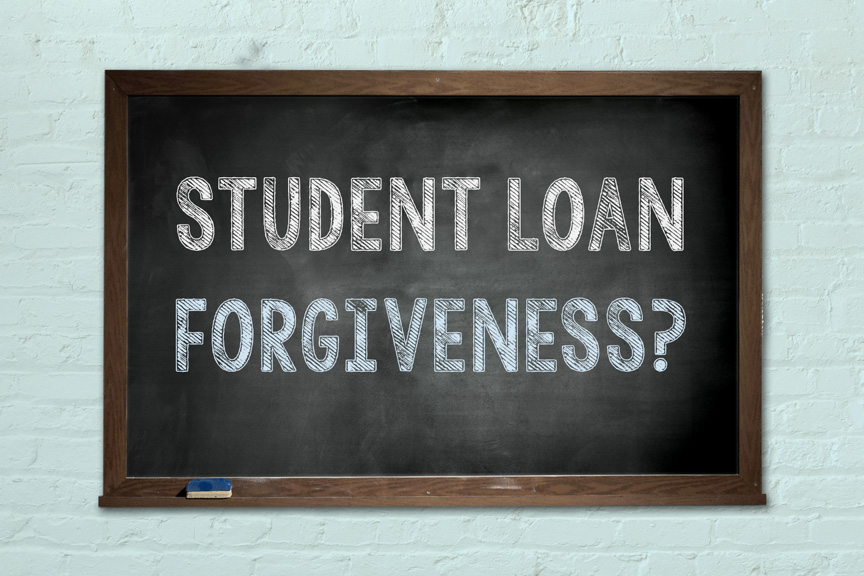You can’t take student loan forgiveness programs at face value. Let’s explore the pros and cons of “forgiveness.”
The Biden Administration has unveiled their plan to forgive up to $10,000 worth of federal student loan debt to millions of Americans, and up to $20,000 for those who received Pell grants. Eligible individuals must be making an annual salary of less than $125,000, and married couples making under $250,000 are also eligible. This initiative has many people feeling relieved to have a big burden off their shoulders, but many others are unhappy with the likely disadvantages this debt relief can bring with it.
While these recent developments have dominated the news cycle, it’s important to remember the methods of student loan forgiveness which already exist, and then look ahead to what’s next in the saga of student loan forgiveness, and why it might not be as forgiving as it may seem.
Existing Forms of Student Loan Forgiveness
Before President Biden’s new plan for student loan forgiveness goes into effect, here are the current ways in which federal student loan debt can be forgiven.
Income-Driven Repayment:
This type of forgiveness plan, also known as IDR is for those who cannot afford a 10-year repayment plan. An IDR plan consists of payments based on a percentage of each person’s discretionary income. The student loan forgiveness kicks in at the end of a 20 to 25-year loan term, forgiving whatever the remaining debt amount is.
Public Service Loan Forgiveness:
Public Service Loan Forgiveness, or PSLF, is available for government or non-profit employees. Individuals are eligible for PSLF after working for their respective agency or organization full-time for 10 years and making 120 qualifying monthly payments during the repayment plan.
Teacher Loan Forgiveness:
Educators are eligible for Teacher Loan Forgiveness after they have worked full-time in a low-income school or educational service agency for five or more consecutive years. This program qualifies teachers, and only teachers, for up to $17,500 in student loan forgiveness.
These programs are only available to those who qualify, are in specific occupations, and/or those who have been paying off their loans for 10+ years. These forgiveness methods are highly specialized and can also be very flawed.
The Downside of Forgiveness
Making Less Money
Many of the qualifying nonprofits and organizations that are eligible for its employees to receive PSLF don’t pay very well. Furthermore, for those occupations within those organizations to be eligible for PSLF, they have to meet a certain pay criteria, which is typically low. Working at a for-profit company tends to yield higher pay, and those companies might even offer student loan repayment assistance, which can be a more helpful and efficient option.
Lower Credit Scores
Many of these student loan forgiveness programs can take a long time to qualify for, leaving a large chunk of debt unpaid and accruing interest. For that reason, waiting for PSLF or IDR can lower your credit score, making it more difficult to get a car loan or a mortgage. Having good credit is vital to financial health and procrastinating on paying off debt can be a liability.
Higher End Costs
Through an IDR plan, loans are paid through smaller monthly payments over a longer period of time. While it’ll be roughly the same interest rate, and a portion of the loan would be forgiven after the 20-25 year repayment plan, the total amount of money you will ultimately pay will be be higher than the original amount that would have been paid through the 10-year repayment plan.
Additionally, forgiven debt through IDR can be taxed as income. While PSLF is not taxable, IDR may be taxable in the future. Student loan forgiveness isn’t currently taxable income, because of the American Rescue Plan Act of 2021, but that expires in 2026. There’s a chance that the bill will be extended, but if it isn’t, forgiven loans could lead to a hefty tax statement in the future.
A Look Ahead
While it’s possible that these forgiveness programs might change in the coming months or years due to the Biden administration’s ongoing plans, the aforementioned drawbacks may still apply to any future loan forgiveness actions. While the new widespread student loan forgiveness plans are welcome news for many borrowers, they do not fix long-standing issues with college costs and student debt which include the following.
What does Biden’s Student Loan Forgiveness Program NOT Fix?
Doesn’t Fix College Costs
One of the primary concerns voiced by economists is that this plan does not take care of the bigger problem of increasing costs to attend college. Rather, this is a small band-aid on a large wound. College costs have risen much quicker than the rate of inflation and forgiving loans now could make those costs continue to go up in the future.
Now that the expectation of widespread student loan forgiveness is set, it might seem like there will be more forgiveness plans in the future, prompting people to be less cautious when taking out large loans and encouraging colleges to raise their tuition prices even further without pressure from the government or American public to offer lower tuition.
Doesn’t Address Increasing Inflation
While this plan is different from the $1,200 COVID-19 relief checks, where money was directly deposited into peoples’ bank accounts, it could still affect inflation over time. Now that millions of Americans will have either less in monthly student loan payments or none at all, overspending could fuel an already out-of-control inflation spike.
With inflation already rising due to consumer demand being greater than what the supply chain can offer, pumping more spending into the economy might seem like a good temporary solution, but it could do more harm than good over time.
Fairness
The problem many debt-free college graduates have had with this new student loan forgiveness plan is the fairness of it all. Yes, the plan is meant to help those college graduates who are struggling to stay afloat due to large student loan debt, but what about those who received little to no student loans, those who have already paid off their student loans, or even those who couldn’t afford college in the first place? Is it truly fair to any of those taxpayers who now have to assist borrowers who can’t afford their debt?
Although these issues can be debated or discounted, the fact still remains that caution is crucial. Even though student loan forgiveness might seem like an easy and appealing way to eliminate debt quickly, it’s not always what it seems.
Our best advice is rather than rely on student loans to afford education, make college as affordable as possible. College doesn’t have to ruin your finances or retirement plans.
For more information on how we can help make college more affordable for your family, reach out to our experts at 610-422-3530 and visit our website. We can help you provide the financial security you need.

